tank tactics guide in urban war pdf
Urban warfare involves intense combat in densely populated areas, requiring unique tactics. Tanks play a critical role due to their firepower but face challenges like ambushes and limited mobility, as seen in historical battles like Grozny and Mogadishu, where their effectiveness was tested in confined environments.
1.1 Definition and Importance of Urban Warfare
Urban warfare refers to military combat conducted in urban areas, characterized by dense populations, infrastructure complexity, and unique tactical challenges. Unlike traditional battlefield scenarios, urban environments present obstacles such as narrow streets, high-rise buildings, and civilian presence, complicating operations. The importance of urban warfare lies in its historical prevalence, as cities often serve as political, economic, and cultural hubs. Understanding urban warfare is crucial for modern militaries, as conflicts increasingly shift to populated areas. Effective urban tactics, including tank operations, are vital to minimize civilian casualties while achieving strategic objectives in these high-stakes environments.
1.2 Historical Context of Urban Combat
Urban combat has been a recurring feature of warfare throughout history, with cities often serving as decisive battlegrounds. From ancient sieges to modern conflicts, urban environments have presented unique challenges due to their density and complexity. The use of tanks in urban warfare emerged during World War II, with battles like Stalingrad showcasing their effectiveness and limitations. Historical examples, such as the Battle of Hue City in Vietnam and the Chechen Wars in Grozny, highlight the evolution of urban tank tactics. These conflicts underscored the need for combined arms approaches and adapted strategies to mitigate vulnerabilities in dense, high-threat environments.
1.3 The Role of Tanks in Urban Warfare
Tanks play a pivotal role in urban warfare, providing heavy firepower and mobility to support infantry in dense, high-threat environments. Their ability to deliver precise firepower and protect troops makes them invaluable in urban combat. However, tanks are vulnerable to ambushes, anti-tank missiles, and improvised explosives in confined spaces. Historical conflicts, such as Grozny and Mogadishu, highlight the importance of coordinating tanks with infantry to mitigate risks. Despite challenges, tanks remain essential for breaching structures, clearing routes, and maintaining momentum in urban operations, as seen in modern conflicts like Mosul and Marawi.

Fundamentals of Tank Tactics in Urban Environments
Urban tank tactics emphasize mobility, cover, and situational awareness. Coordination with infantry and engineers is crucial for navigating obstacles and mitigating anti-tank threats in dense environments.
2.1 Key Principles of Urban Tank Warfare
Key principles of urban tank warfare include coordination with infantry and engineers to clear paths, situational awareness to avoid ambushes, and using cover like buildings. Tanks must navigate confined spaces cautiously, avoiding chokepoints. Crews should maintain overlapping fields of fire and ensure communication with supporting units. Urban terrain demands adaptive tactics, such as bypassing heavily contested areas and utilizing indirect firing positions. These strategies enhance survivability and effectiveness in densely populated environments, where traditional open-field tactics often fail.
2.2 Advantages and Limitations of Tanks in Cities
Tanks in urban warfare offer significant firepower, enabling them to breach structures and provide cover for infantry. Their armor protects crews from small arms fire, making them invaluable in high-threat environments. However, tanks are vulnerable to anti-tank missiles and improvised explosives in confined spaces. Narrow streets and rubble hinder mobility, while tall buildings obscure visibility. Urban environments amplify logistical challenges, as tanks require constant maintenance and fuel. Despite these limitations, tanks remain crucial for overwhelming enemy strongpoints and supporting ground forces, provided they operate with infantry and engineering support to mitigate risks.
2.3 Basic Tactics for Tank Crews in Urban Settings
Tank crews in urban environments must adopt cautious movement, avoiding chokepoints where ambushes are likely. Utilizing cover, such as buildings and rubble, is crucial to minimize exposure. Coordination with infantry is essential, as tanks provide suppressive fire while troops clear buildings. Crews should maintain situational awareness, scanning rooftops and alleyways for threats. Communication must be clear and constant, ensuring seamless coordination. Tanks should engage targets methodically, prioritizing anti-tank threats. Limiting speed and using smoke screens can enhance survivability. These tactics balance the tank’s firepower with the vulnerabilities of urban terrain, ensuring effective and safe operations.
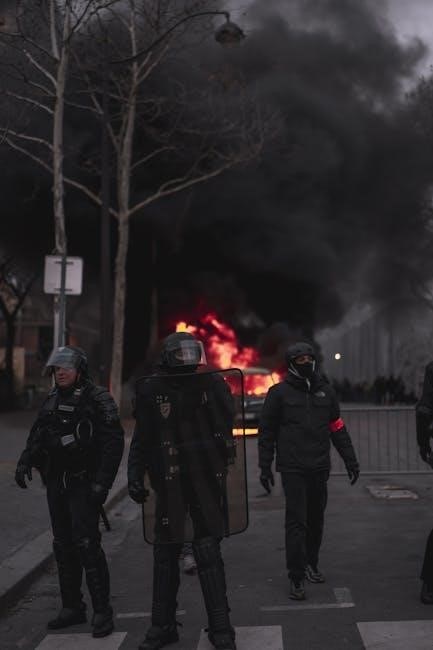
Case Studies of Urban Tank Warfare
Historical battles like Grozny, Mogadishu, and Hue City highlight the challenges and lessons learned in urban tank operations, shaping modern tactical approaches.
3.1 The Battle of Grozny: Lessons Learned
The Battle of Grozny during the Chechen Wars exposed critical vulnerabilities in urban tank operations. Russian tanks, often deployed without sufficient infantry support, suffered heavy losses from anti-tank missiles and improvised explosives. The urban terrain limited visibility and maneuverability, making tanks easy targets. These experiences underscored the necessity of combined arms tactics, where tanks and infantry coordinate closely to mitigate risks. Grozny also highlighted the importance of advanced reconnaissance and adaptive strategies to counter asymmetric threats in dense urban environments. These lessons remain pivotal for modern urban warfare doctrine, emphasizing the need for integrated military approaches to enhance survivability and operational success in cities.
3.2 Tank Operations in Mogadishu (1993)
Tank operations in Mogadishu during 1993 highlighted the challenges of urban combat. U.S. forces faced fierce resistance from Somali militias, who employed ambush tactics and improvised explosives. Tanks provided crucial firepower but struggled with narrow streets and limited visibility, making them vulnerable to anti-tank missiles. The operation underscored the importance of close air support and infantry coordination. Lessons learned emphasized the need for better intelligence, adaptive tactics, and combined arms integration to mitigate risks in urban environments. Mogadishu remains a key case study for understanding the complexities of tank operations in densely populated areas.
3.3 Urban Tank Warfare in Hue City (1968)
The Battle of Hue City during the Vietnam War showcased the challenges of urban tank warfare. U.S; forces utilized M48 Patton tanks to support infantry in dense urban terrain, where narrow streets and rubble hindered mobility. Tanks provided critical firepower against entrenched enemy positions but faced vulnerabilities from anti-tank weapons and improvised explosives. The operation highlighted the importance of close infantry-tank coordination and the need for adaptable tactics in urban environments. Lessons from Hue City emphasized the limitations of tanks in confined spaces and the necessity of combined arms strategies to overcome urban combat challenges effectively.
3.4 Modern Examples: Tank Tactics in Mosul and Marawi
Recent urban conflicts in Mosul and Marawi highlighted the evolving role of tanks in modern warfare. In Mosul, Iraqi forces used tanks to breach ISIS defenses, while in Marawi, Philippine troops employed armor to counter insurgent strongpoints. Both campaigns underscored the importance of coordinated tank-infantry operations and the use of precision firepower to minimize collateral damage. However, the dense urban terrain and improvised explosive devices posed significant challenges, emphasizing the need for adaptive tactics and robust logistical support. These battles provided valuable lessons for future urban tank warfare strategies.
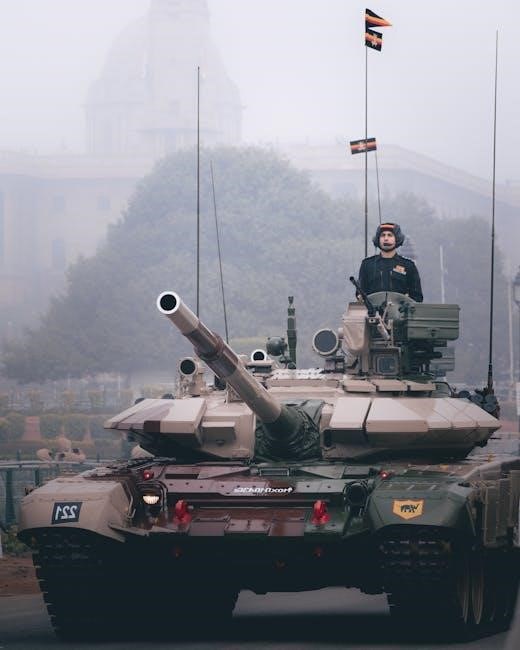
Challenges of Urban Tank Warfare
Urban tank warfare faces unique challenges, including ambush risks, limited visibility, civilian casualties, and logistical complexities. These factors demand advanced tactics and specialized equipment to mitigate risks effectively.
4.1 Ambushes and Anti-Tank Missile Threats
Urban environments present significant risks of ambushes and anti-tank missile threats, as narrow streets and tall buildings provide ideal vantage points for attackers. The proliferation of portable anti-tank missiles, such as those used in conflicts like Grozny and Mogadishu, has made tanks vulnerable in densely populated areas. These weapons can inflict severe damage, even on heavily armored vehicles, necessitating advanced countermeasures. Additionally, the confined spaces of cities limit maneuverability, making tanks easy targets for coordinated ambushes. Addressing these threats requires a combination of infantry support, active protection systems, and strategic route planning to minimize exposure.
4.2 Narrow Streets and Limited Visibility
Narrow streets and limited visibility are critical challenges in urban warfare, restricting tank maneuverability and creating blind spots. Tall buildings and rubble provide cover for enemy forces, enabling ambushes and surprise attacks. Tanks must navigate carefully to avoid bottlenecks, where they become easy targets for anti-tank missiles and improvised explosive devices. Limited visibility also complicates coordination with infantry and other units, increasing the risk of friendly fire. Historical examples, such as the Battle of Grozny, highlight how confined urban spaces can negate the advantages of tank firepower, making adaptive tactics and advanced reconnaissance essential for success in such environments.
4.3 Civilian Presence and Collateral Damage
Urban warfare often involves dense civilian populations, making collateral damage a significant concern. Tanks, with their immense firepower, pose a high risk of unintended harm to non-combatants. The presence of civilians complicates tactical decisions, as avoiding civilian casualties while achieving military objectives becomes a delicate balance. Historical conflicts, such as those in Grozny and Mogadishu, highlight the humanitarian and moral dilemmas of urban tank operations. The destruction of infrastructure and civilian lives can erode public support and create long-term instability, underscoring the need for precise targeting and minimized use of heavy armor in densely populated areas.
4.4 Maintenance and Logistics in Urban Environments
Maintenance and logistics in urban warfare present unique challenges for tank operations. The confined and chaotic environment often disrupts supply lines, making the resupply of fuel, ammunition, and spare parts difficult. Urban terrain, with its narrow streets and debris, increases wear and tear on tanks, necessitating more frequent repairs. Additionally, the risk of ambushes and anti-tank missile threats complicates maintenance efforts, as crews must operate under constant threat. Effective logistical planning and rapid repair capabilities are essential to sustain tank operations in urban settings, ensuring continued combat readiness amidst the challenges of city warfare.
Coordination Between Tanks and Infantry
Coordination between tanks and infantry in urban warfare ensures mutual support and protection, with tanks providing firepower and cover, and infantry offering situational awareness and neutralizing threats for secure advances.
5.1 The Necessity of Combined Arms Tactics
Combined arms tactics are crucial in urban warfare, integrating tanks with infantry, engineers, and air support to enhance operational effectiveness. Tanks provide suppressive fire and breach barriers, while infantry ensures close-quarters security and neutralizes hidden threats. This synergy minimizes vulnerabilities, such as tank ambushes, and maximizes mission success in densely populated areas. Historical examples like Mogadishu highlight the importance of such coordination, where disjointed efforts led to significant losses. Effective communication and precise planning are essential to synchronize these elements, ensuring seamless execution in high-stress urban environments.
5.2 Infantry Support for Tank Operations
Infantry support is vital for effective tank operations in urban environments. Foot soldiers provide critical protection by clearing buildings, neutralizing hidden threats, and securing key routes. Tanks, in turn, offer suppressive fire and mobility, enabling infantry to advance safely. This mutual dependence ensures coordinated maneuvers, minimizing vulnerabilities. Historical conflicts, such as the Chechen Wars, highlight the risks of deploying tanks without sufficient infantry backing, leading to heavy losses. Proper synchronization between tanks and infantry enhances mission success, ensuring urban terrain challenges are effectively overcome through teamwork and strategic coordination. This synergy is essential for achieving objectives in densely populated combat zones.
5.3 Communication Strategies in Urban Combat
Effective communication is crucial in urban combat, particularly between tank crews and infantry. Clear and concise messaging ensures seamless coordination, reducing misunderstandings. Urban environments, with their dense infrastructure, often disrupt radio signals, requiring reliable backup systems. Visual signals, such as hand gestures or flares, can supplement electronic communication. Additionally, pre-established protocols and codes enhance rapid decision-making. Modern advancements, like encrypted networks and real-time data sharing, improve situational awareness. Successful missions rely on robust communication strategies that adapt to the dynamic and unpredictable nature of urban warfare, ensuring all units remain synchronized and informed throughout operations.

Modern Tank Tactics in Urban Warfare
Modern urban tank tactics emphasize adaptability, technology integration, and precision. Advanced armor, night vision, and drones enhance effectiveness in urban environments, ensuring safer and more strategic operations.
6.1 The Use of Drones in Urban Reconnaissance
Drones have revolutionized urban reconnaissance, providing real-time intelligence on enemy positions and hidden threats like anti-tank missiles and IEDs. Their ability to navigate densely populated areas enables precise mapping of routes and identification of ambush zones. Equipped with thermal imaging, drones can detect heat signatures, aiding in the identification of concealed enemy assets. This enhances situational awareness, allowing tank crews to make informed decisions and avoid high-risk areas. By integrating drones, urban tank operations become more efficient, reducing the likelihood of ambushes and improving overall mission success in complex environments.
6.2 Advanced Armor and Countermeasures
Advanced armor and countermeasures are critical in urban tank warfare, offering enhanced protection against anti-tank missiles, IEDs, and ambush threats. Modern tanks employ Active Protection Systems (APS) to detect and neutralize incoming projectiles. Reactive armor provides additional defense by detonating upon impact, reducing damage from explosions. Composite armor layers offer comprehensive protection against diverse urban threats. These technologies integrate to create a layered defense system, boosting tank survivability in dense, high-risk environments. Such advancements not only protect crews but also deter enemy engagements, demonstrating superior resilience in urban combat scenarios.
6.3 Night Vision and Thermal Imaging in Urban Combat
Night vision and thermal imaging systems are pivotal in urban tank warfare, enabling crews to operate effectively in low-light environments. These technologies enhance situational awareness, allowing tanks to detect hidden threats like snipers or ambushes. Thermal imaging penetrates smoke and debris, identifying enemy positions behind obstacles. Night vision systems, often integrated with weapon sights, ensure accurate targeting under cover of darkness. Together, these tools minimize the urban battlefield’s visibility challenges, enabling tanks to maintain operational dominance and protect infantry forces during nocturnal or obscured operations, thus enhancing overall mission success and crew safety.

Psychological Aspects of Urban Tank Warfare
Urban combat strains tank crews mentally due to confined, high-threat environments and civilian presence. Psychological resilience is crucial to maintain focus and morale under intense stress.
7.1 The Impact on Civilians
Urban tank warfare significantly affects civilians, causing displacement, injuries, and fatalities. The presence of heavy armor in densely populated areas often leads to widespread destruction of infrastructure, disrupting essential services like healthcare and water supply. Civilians caught in crossfire face immense psychological trauma, exacerbating humanitarian crises. Additionally, the use of anti-tank missiles and improvised explosives in urban settings further endangers non-combatants, highlighting the need for precise tactics to minimize collateral damage. The ethical challenges of balancing military objectives with civilian safety remain a critical concern in modern urban conflicts.
7.2 Morale of Tank Crews in Urban Combat
Urban combat poses significant psychological challenges for tank crews, affecting their morale. The confined, high-threat environment increases stress and fatigue, as crews face constant ambush risks and anti-tank missile threats. Prolonged exposure to urban warfare can lead to decreased motivation and operational effectiveness. However, well-trained crews with strong leadership tend to maintain higher morale, as they rely on teamwork and trust to navigate the chaos. Recognizing their contributions and ensuring clear communication also play a crucial role in sustaining morale during intense urban operations. Maintaining crew cohesion is essential for overcoming the mental and physical demands of urban tank warfare.
7.3 Psychological Warfare in Urban Environments
Psychological warfare in urban environments targets the minds of both civilians and combatants, aiming to erode morale and create fear. Tanks, as symbols of power, can intimidate enemy forces and civilians, undermining their will to resist. Conversely, urban warfare’s unpredictability and civilian presence can heighten stress for tank crews, affecting their mental resilience. Effective psychological tactics include propaganda, misinformation, and demonstrations of overwhelming force. Countering these requires strong leadership, clear communication, and resilience training to maintain crew confidence and operational focus amidst the urban battlefield’s psychological pressures.

Training for Urban Tank Warfare
Training for urban tank warfare focuses on simulating real-world scenarios, emphasizing adaptive tactics, crew coordination, and stress resilience to prepare for the challenges of urban combat environments.
8.1 Simulating Urban Environments for Training
Simulating urban environments for training is crucial for preparing tank crews to navigate confined spaces, avoid ambushes, and coordinate with infantry. Mock cities with narrow streets, rubble, and civilians are constructed to mimic real-world scenarios. Crews practice navigating obstacles, engaging hidden threats, and maintaining situational awareness. These simulations also incorporate scenario-based exercises, such as responding to anti-tank missile threats and recovering disabled tanks. The goal is to build adaptive skills and teamwork, ensuring crews can operate effectively in the chaos of urban combat.
8.2 Crew Training and Drill Exercises
Crew training and drill exercises are essential for mastering urban tank warfare. These exercises focus on improving coordination, communication, and decision-making under pressure. Tank crews rehearse scenarios like navigating tight spaces, engaging targets, and responding to ambushes. Drills emphasize rapid target acquisition, precision firing, and maintaining situational awareness. Training also includes mock urban environments to simulate real-world challenges. Repetition builds muscle memory, ensuring crews can execute tactics seamlessly. Feedback sessions and debriefs help identify weaknesses and refine strategies. Effective training ensures tank crews are prepared to operate cohesively in the high-stress environment of urban combat.
8.3 Adaptive Tactics for Urban Scenarios
Adaptive tactics are crucial for urban warfare, where environments are dynamic and unpredictable. Crews must adjust strategies based on real-time intelligence, civilian movements, and enemy behavior. Urban scenarios demand quick decision-making, such as navigating narrow streets, avoiding ambushes, and exploiting cover. Tanks must often operate in close coordination with infantry to clear buildings and secure routes. Adaptive tactics also involve using advanced tools like drones for reconnaissance and thermal imaging for nighttime operations. These strategies ensure flexibility and resilience, enabling tank crews to overcome the unique challenges of urban combat effectively while minimizing collateral damage and civilian risk.
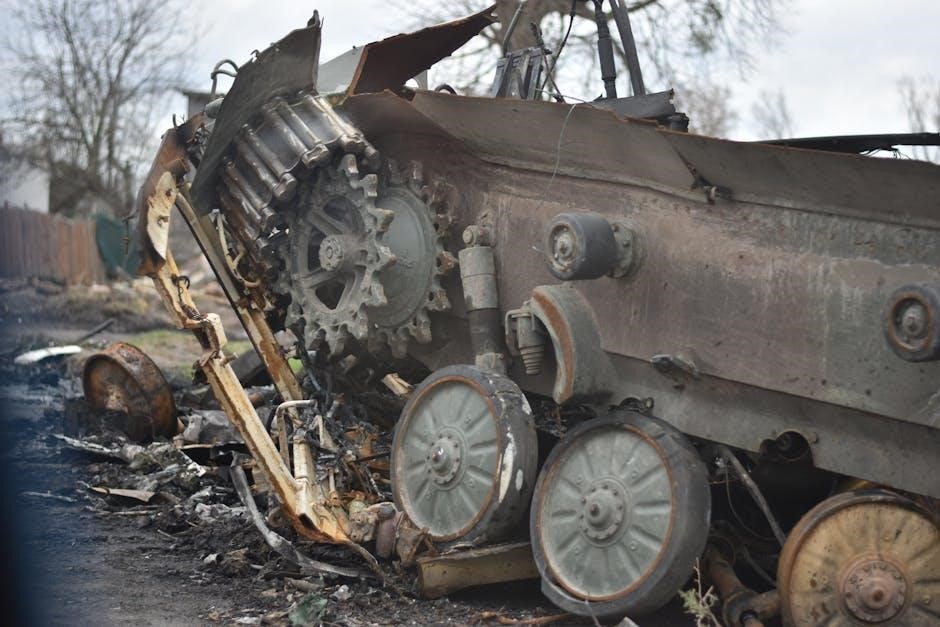
The Role of Engineering and Support Units
Engineering and support units are vital in urban warfare, enabling tank operations by clearing obstacles, establishing forward bases, and ensuring logistical support for sustained combat effectiveness.
9.1 Clearing Obstacles in Urban Terrain
Clearing obstacles in urban terrain is essential for tank operations, as rubble, debris, and improvised barriers can block movement. Engineering units use specialized equipment, such as mine rollers and bulldozers, to create pathways through densely populated areas. Narrow streets and collapsed structures often require precise breaching techniques to ensure tanks can maneuver effectively. Additionally, engineers must identify and neutralize improvised explosive devices (IEDs) and other hazards, which are common in urban warfare. Effective obstacle clearance enables tanks to maintain mobility and support infantry advances, while poor clearance can lead to mission delays or catastrophic losses. Coordination between engineers and tank crews is critical to ensure safe and efficient operations in such environments.
9.2 Establishing Forward Operating Bases
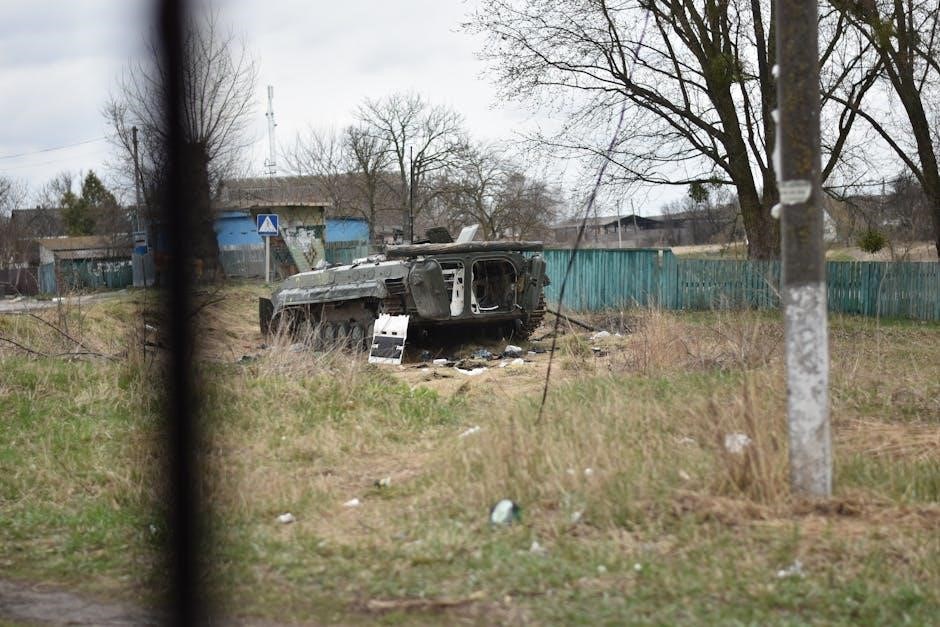
Establishing forward operating bases (FOBs) in urban environments is critical for sustaining tank operations. FOBs serve as logistical hubs for fuel, ammunition, and maintenance, ensuring continuous support for urban warfare. Key considerations include selecting defensible locations, proximity to urban combat zones, and infrastructure for tank servicing. Security is paramount, with sentry units and surveillance systems deployed to prevent attacks. Coordination between engineering units, infantry, and tank crews ensures FOBs are well-integrated into urban operations. Despite challenges like limited space and hostile environments, FOBs remain essential for maintaining operational tempo and effectiveness in urban warfare scenarios.
9.3 Repair and Recovery of Tanks in Urban Settings
Repairing and recovering tanks in urban environments presents unique challenges due to confined spaces, rubble, and potential ambushes. Specialized recovery teams equipped with cranes, winches, and armored vehicles are essential for extracting damaged tanks while minimizing risks. Mobile repair units can perform basic fixes on-site, reducing the need for lengthy evacuations. Advanced tools and rapid response protocols ensure tanks return to combat readiness swiftly, maintaining operational momentum. These efforts are critical in sustaining tank effectiveness and ensuring mission continuity in densely populated and hostile urban zones.
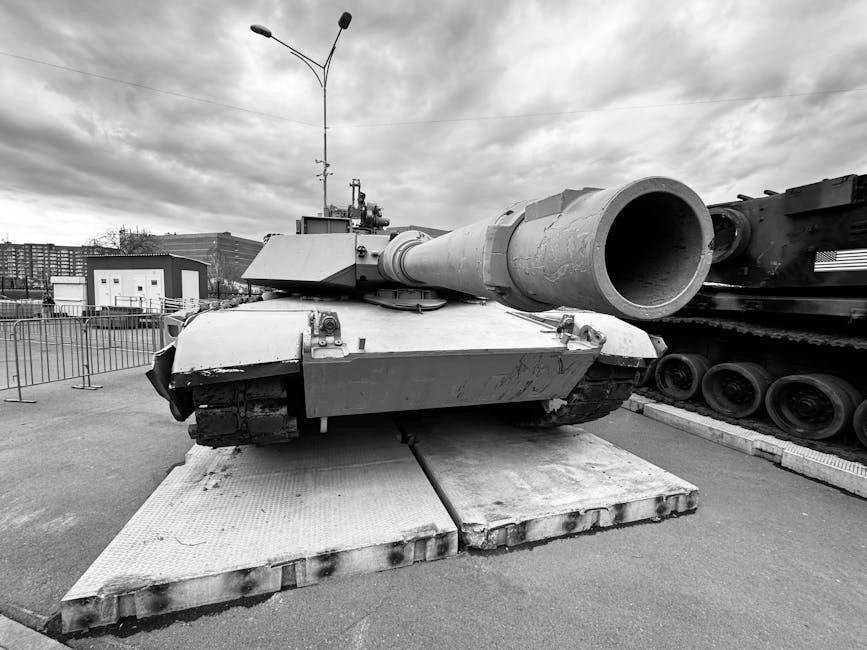
The Future of Urban Tank Warfare
Emerging technologies, including autonomous vehicles, advanced armor, and enhanced coordination systems, will redefine urban tank warfare, emphasizing precision, adaptability, and reduced collateral damage in future conflicts.
10.1 Emerging Technologies in Urban Warfare
Emerging technologies are revolutionizing urban tank warfare, with advancements in autonomous systems, AI-driven targeting, and advanced armor materials. Drones now play a pivotal role in reconnaissance, providing real-time battlefield data to tank crews. AI enhances decision-making, enabling faster threat detection and precision strikes. Additionally, next-generation armor incorporates reactive materials to counter anti-tank missiles. These innovations aim to improve survivability, lethality, and operational efficiency in dense urban environments, addressing historical vulnerabilities and ensuring tanks remain effective in future conflicts.
10.2 The Role of Autonomous Vehicles in Future Conflicts
Autonomous vehicles are poised to transform urban warfare, reducing risks to human crews while enhancing operational efficiency. These systems can navigate complex urban terrains, avoiding ambushes and detecting threats using advanced sensors and AI. Autonomous tanks could operate in contested zones, conducting reconnaissance or clearing paths for infantry. Integration with drones and other unmanned systems will create seamless battlefield networks. The U.S. Army’s “Optionally Manned Fighting Vehicle” concept exemplifies this shift, offering versatility in urban combat. However, challenges like cybersecurity and ethical concerns must be addressed to ensure reliable deployment in future conflicts.
10.3 Evolving Tactics for Asymmetric Warfare
Asymmetric warfare demands adaptive tactics, especially in urban settings where non-state actors exploit terrain and civilian presence. Tanks must integrate with infantry for precision strikes, minimizing collateral damage. Advanced sensors and real-time data enable better target discrimination, reducing risks to non-combatants. Urban warfare training now emphasizes combined arms operations, ensuring tanks operate in synergy with drones and dismounted troops. The rise of anti-tank missiles necessitates improved active protection systems and maneuver tactics. Future conflicts will require tanks to be more agile, networked, and capable of executing decentralized operations, aligning with the evolving nature of urban asymmetric threats.
Urban tank warfare remains a complex, evolving discipline, balancing firepower with vulnerability. Historical lessons underscore the need for adaptive tactics, emphasizing coordination and innovation to address modern challenges effectively;
11.1 Summary of Key Takeaways
Urban tank warfare is a complex and dynamic field, requiring careful balance between firepower and vulnerability. Key lessons include the necessity of combined arms tactics, where tanks and infantry must operate in close coordination. Historical case studies, such as Grozny and Mogadishu, highlight the risks of deploying tanks without sufficient support. Modern advancements, like drones and thermal imaging, have enhanced operational effectiveness. However, challenges like ambushes, narrow streets, and civilian presence remain critical concerns. Adaptive training and innovative strategies are essential to address these issues, ensuring tanks remain a viable asset in urban combat while minimizing collateral damage and civilian harm.
11.2 The Ever-Changing Nature of Urban Warfare
Urban warfare is inherently dynamic, with tactics and strategies evolving rapidly due to technological advancements and shifting urban landscapes. The increasing use of drones, night vision, and thermal imaging has transformed how tanks operate in cities, offering new offensive and defensive capabilities. However, these advancements also introduce new challenges, such as countering anti-tank missiles and adapting to asymmetric warfare. The dense, ever-changing environment demands continuous innovation in tactics, emphasizing the need for tanks to remain versatile and adaptable. As urbanization accelerates, the complexity of urban warfare will only intensify, requiring constant refinement of tank tactics to stay effective.
11.3 Final Thoughts on Tank Tactics in Urban War
Tank tactics in urban warfare remain a critical component of modern conflict, requiring constant adaptation to evolving threats and environments. Historical lessons from battles like Grozny and Mogadishu underscore the need for combined arms tactics, where tanks and infantry operate in close coordination. The integration of advanced technologies, such as drones and thermal imaging, has enhanced operational effectiveness but also introduced new complexities. Urban warfare demands innovative strategies to mitigate risks like ambushes and collateral damage. As urbanization accelerates, the role of tanks must evolve to address future challenges, ensuring they remain a viable and effective force in the dynamic, high-stakes environment of city combat.
